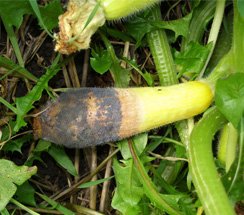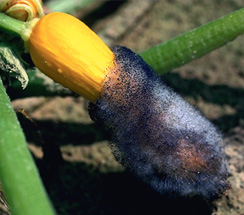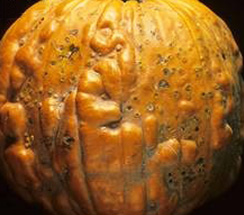| Choanephora wet rot: Choanephora cucurbitarum |
Symptom:
- Attacks the blossoms first and progresses into the developing fruit causing a wet rot at the blossom end
- Fruit rot progresses rapidly and can affect entire fruit within one or two days
- Sporulation by the fungus appears as spines with dark heads on the surface of infected tissues
|
| |
 |
 |
 |
| |
Wet rot at blosoom end |
Fungal spores on squash |
Pumpkin choanephora rot |
|
Identification of pathogen:
- Fungus produces both conidia and sporangiophores
- Conidiophores - unbranched and has a spherical head
Mode of spread and survival:
- Attacks cauliflower, cotton, cucumber, pumpkin, radish and squash
- Survive as a saprophyte - as chlamydospores and zygospores
- Spread - air, beetles and bees
|
Management:
Crop management practices
- Reduce soil moisture (raised beds)
- Prevent fruit injury
- Prevent soil contact with the soil (plastic mulches or trellising)
Post harvest losses may be reduced by
- Harvesting fruits at proper stage of maturity
- Minimizing cucurbit fruit injuries at harvest
- Pre cooling fruit
- Maintaining relatively low storage temperature
|
Source of Images:
http://www.apsnet.org/publications/imageresources/Pages/IW00007.aspx
http://www.extension.umn.edu/garden/yard-garden/vegetables/diseases-of-cucurbits/choanephora-rot/
http://extension.cropsciences.illinois.edu/fruitveg/pdfs/950_fruits_rots_pumpkin.pdf
|



